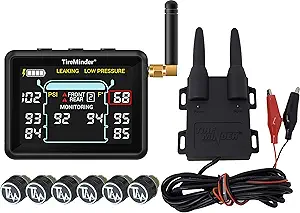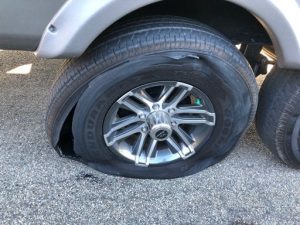The Ultimate Guide to Preventing RV Tire Blowouts: Protecting Your Journey
Nothing derails an exciting RV adventure faster than a tire blowout on the open road. For RV owners, tire failures aren’t just inconvenient—they can be dangerous, costly, and potentially catastrophic, especially when they occur in remote locations.
According to research, nearly 45% of Americans have experienced a tire blowout while driving, with RVs being particularly vulnerable due to their unique characteristics and usage patterns. This comprehensive guide will explore why RVs face a higher risk of tire failures and provide actionable strategies to significantly reduce these risks.
Why RV Tires Are More Prone to Blowouts
RVs face unique challenges that make their tires particularly susceptible to blowouts compared to standard vehicles:
1. Increased Weight Distribution
RVs typically carry substantially more weight than passenger vehicles. This additional “load weight”—everything from water tanks to camping gear—places significant stress on tires, making them work harder under normal driving conditions.
2. Extended Highway Travel
Many RV adventures involve long-distance highway driving, often for hours at a time. This extended high-speed travel generates considerable heat within tires due to friction, which can build to dangerous levels if not properly managed.
3. Diverse Terrain Challenges
From smooth highways to rough campground access roads, RVs frequently traverse varied terrain—sometimes within a single day’s journey. This diversity makes matching the right tires to your travel style particularly important.
4. Seasonal Usage Patterns
Unlike daily-use vehicles, many RVs sit unused for extended periods between trips. This intermittent usage pattern can accelerate tire degradation through a process called “dry rot,” making regular inspection crucial.
Essential Prevention Strategies
Monitor Your Weight Carefully
One of the most effective ways to prevent tire failures is ensuring your RV stays within its designed weight capacity.
- Locate your RV’s Gross Vehicle Weight Rating (GVWR) in your owner’s manual—this indicates the maximum weight your vehicle can safely carry, including passengers and cargo
- Consider visiting a truck weighing station if you’re concerned about potential overloading
- Distribute weight evenly throughout your RV to prevent excessive stress on any single tire
- When packing, prioritize essentials and eliminate unnecessary items that add weight
Exceeding your RV’s weight limits doesn’t just risk tire failure—it places additional strain on your braking system, suspension, and overall handling.
Maintain Proper Tire Pressure
Underinflation represents the leading cause of tire blowouts in RVs. When tires lack sufficient air pressure, excessive flexing occurs as you drive, generating dangerous heat levels.
- Check tire pressure at least monthly, or weekly during active travel periods
- Always measure pressure when tires are “cold” (before driving or after resting at least 2 hours)
- Follow manufacturer’s specific pressure recommendations rather than relying on the maximum PSI listed on the tire sidewall
- Be aware that tires typically lose about 2-3 PSI per 1,000 miles traveled
- Invest in a quality tire pressure monitoring system (TPMS) that provides real-time alerts
- Remember that at 25% underinflation, blowout risk doubles compared to properly inflated tires
- Carry a reliable portable air compressor specifically designed for RV applications
A quali
Prevent Dry Rot Damage
Tire dry rot—the deterioration of rubber compounds over time—poses a particular threat to RVs that often sit unused for extended periods.
- Store your RV indoors or under protective covering whenever possible
- If outdoor storage is necessary, use tire covers to shield against UV exposure
- Keep tires away from ozone-producing equipment like generators and battery chargers
- Move your RV periodically during storage to prevent flat spots and maintain circulation
- Look for warning signs, including visible cracks, brittleness, or discoloration
- Consider tire treatments specifically designed to moisturize and protect rubber compounds
- Replace tires showing significant dry rot, regardless of remaining tread depth
Many experienced RVers follow the “six-year rule”—replacing tires at this interval regardless of appearance, as internal degradation may not be visible.
Manage Heat Build-Up
Excessive heat represents a primary enemy of tire integrity. Managing temperature becomes particularly important during summer travel or extended highway driving.
- Plan driving schedules to avoid the hottest parts of the day when possible
- Take regular breaks during highway travel—aim for 30 minutes of rest for every 2 hours of driving
- Consider parking on grass rather than hot pavement during summer stops
- Monitor tire temperature during travel, especially on hot days
- Maintain moderate speeds, as higher speeds generate more friction and heat
- Consider low rolling resistance tires for primarily highway travel as they generate less heat
Heat-related blowouts become significantly more likely when combined with other risk factors like improper inflation or excessive weight.
Choose the Right Tires for Your Travel Style
Different RV travel patterns require different tire characteristics. Matching your tires to your typical usage can significantly reduce blowout risks.
- For primarily highway travel: Consider low rolling resistance tires that generate less heat at sustained speeds
- For varied terrain: All-terrain tires provide better durability on changing road surfaces
- For occasional off-road use: Select higher ply-rated tires (10-12 ply) for additional durability
- Always replace tires with the exact size and load rating specified by your RV manufacturer
- Consider upgrading to tires with higher load ratings if you frequently travel with maximum cargo
Remember that even premium tires can fail if used improperly—always match tire selection with intended usage patterns.
Implement Regular Inspection Routines
Developing a consistent tire inspection habit represents a crucial protection against blowouts.
- Before each trip: Perform a comprehensive visual inspection of all tires
- During trips: Quickly examine tires during fuel stops or rest breaks
- Look for uneven wear patterns that might indicate alignment or suspension issues
- Check sidewalls for bulges, cuts, or visible damage
- Examine valve stems for cracking or corrosion
- Monitor tread depth regularly, replacing tires before they reach minimum safe levels
- Consider professional inspection annually, especially before major trips
Many experienced RVers follow a simple pre-departure checklist that includes a thorough tire inspection.
Upgrade Your Suspension System
While not directly tire-related, your RV’s suspension system plays a crucial role in how weight transfers to your tires during travel.
- Consider aftermarket suspension enhancements designed specifically for RVs
- Upgraded stabilizers can reduce sway and improve weight distribution
- Modern suspension systems can better absorb road impacts that might otherwise damage tires
- Proper alignment ensures even tire wear and reduces stress on tire sidewalls
Quality suspension components not only improve ride comfort but can significantly extend tire life.
What To Do If a Blowout Occurs
Despite your best prevention efforts, blowouts remain a possibility. Knowing how to respond can prevent a bad situation from becoming dangerous:
- Resist the instinct to brake suddenly—maintain a firm grip on the steering wheel
- Focus on steering straight ahead while gradually reducing speed
- Activate hazard lights to alert other drivers
- Move completely off the roadway before stopping if possible
- Set up appropriate warning devices before changing the tire
- Consider professional assistance if the blowout has caused additional damage
Practice mental preparation for this scenario, as proper handling during the first few seconds can prevent loss of control.
Final Thoughts
RV tire blowouts aren’t entirely preventable, but implementing these proactive strategies can dramatically reduce your risk while traveling. Remember that tire safety isn’t just about preventing inconvenience—it’s about protecting yourself, your passengers, and your valuable investment.
By understanding the unique challenges RV tires face and implementing regular maintenance practices, you can significantly improve your odds of trouble-free travels. Your tires literally carry the weight of your adventures—give them the attention they deserve.
Remember: the small amount of time invested in tire care pays tremendous dividends in safety, reliability, and peace of mind during your journeys.

